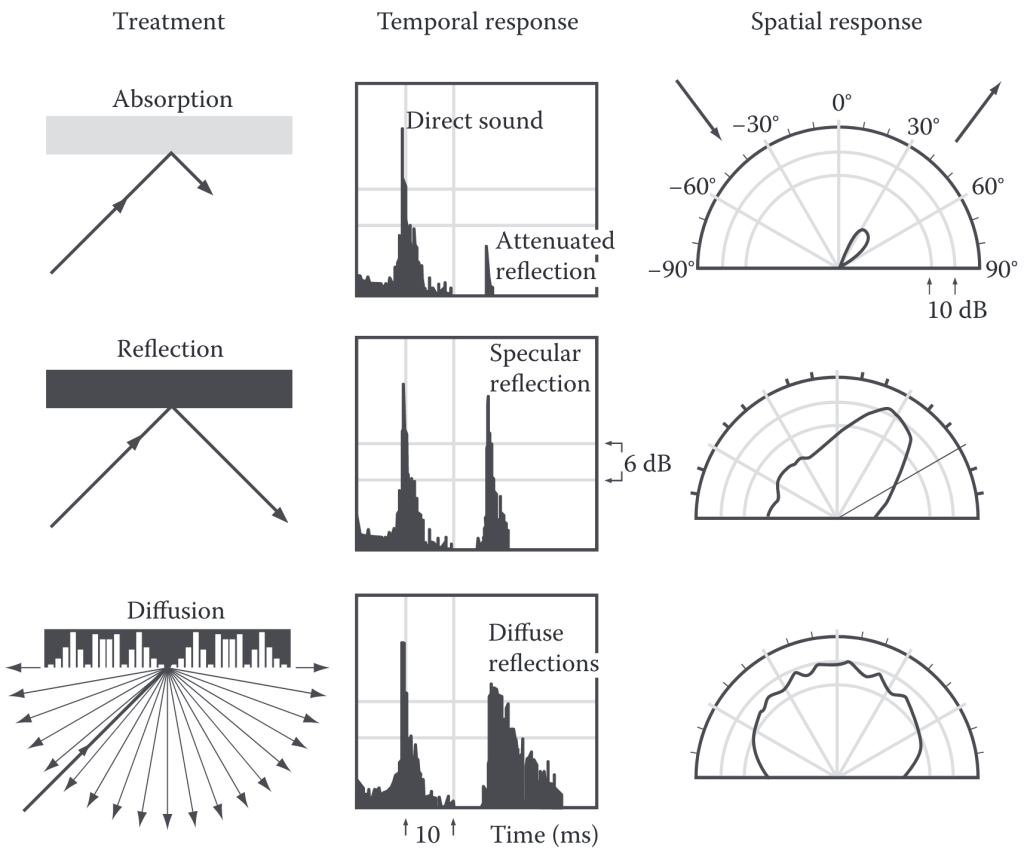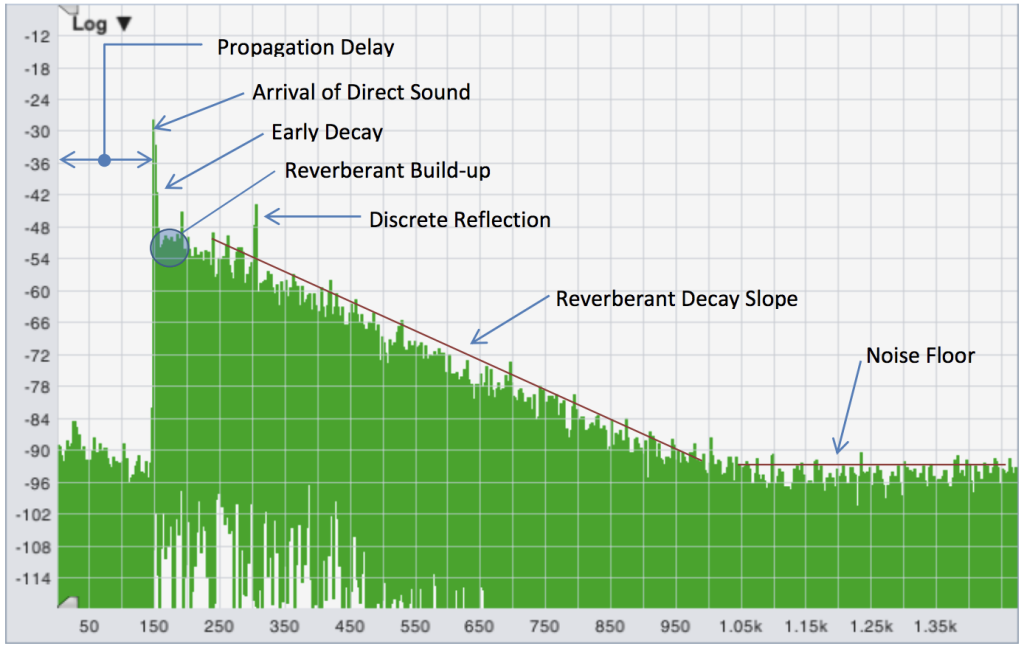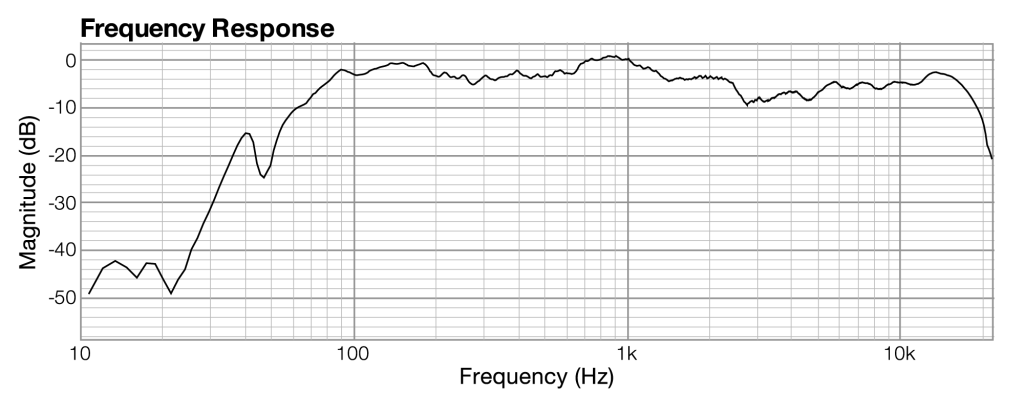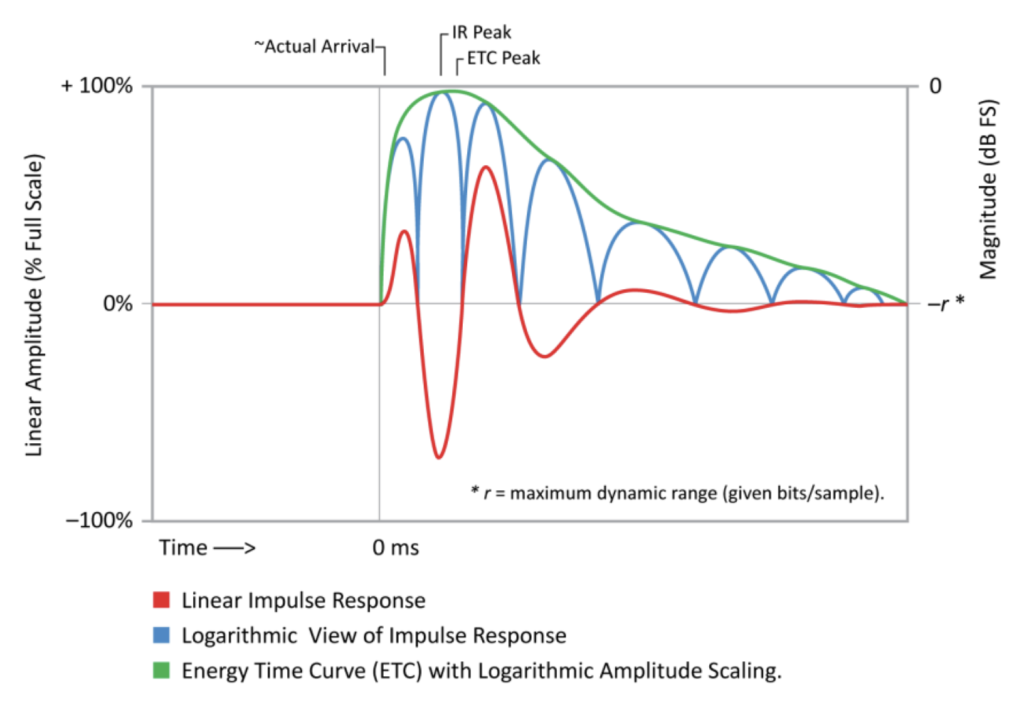Here you can find useful tools, definitions of acoustic terms, and further reading material.
Tools
Realtime Ray-tracing Sketchpad
Definitions
Sound striking a surface is transmitted, absorbed, or reflected; the amount of energy going into transmission, absorption, or reflection depends on the surface’s acoustic properties. The reflected sound can either be redirected by large flat surfaces (specularly reflected) or scattered by a diffusing surface. When a significant portion of the reflected sound is spatially and temporally dispersed, this is a diffuse reflection, and the surface involved is often termed a diffuser.

Reverberation time
The time it takes for sound to decrease by 60 dB (RT60).
| Designation | Unit | Standard |
|---|---|---|
| RTdB | sec | ISO 3382-1 / 2 |
Early Decay Time
The time needed for the sound level to drop by 10 dB.
| Designation | Unit | Standard |
|---|---|---|
| EDT | sec | ISO 3382-1 / 2 |
Clarity
Compares the sound energy in early sound reflexes with those that arrive later. C50 is mostly used for speech and C80 is mainly used for music. The higher the value the better the clarity.
| Designation | Unit | Standard |
|---|---|---|
| Cms | dB | ISO 3382-1 |
Speech Transmission Index
The quality of speech transfer from speaker to listener.
| Designation | Unit | Standard |
|---|---|---|
| STI | 0.00-1.00 | IEC 60268-16 |
| STI | Quality according to IEC 60268-16 | Intelligibility of syllables in % | Intelligibility of words in % | Intelligibility of sentences in % |
|---|---|---|---|---|
| 0 – 0.3 | bad | 0 – 34 | 0 – 67 | 0 – 89 |
| 0.3 – 0.45 | poor | 34 – 48 | 67 – 78 | 89 – 92 |
| 0.45 – 0.6 | fair | 48 – 67 | 78 – 87 | 92 – 95 |
| 0.6 – 0.75 | good | 67 – 90 | 87 – 94 | 95 – 96 |
| 0.75 – 1 | excellent | 90 – 96 | 94 – 96 | 96 – 100 |
Absorption Coefficient
Indicates the proportion of sound which is absorbed by the surface compared to the proportion which is reflected back into the room.
The absorption coefficient varies with frequency and so is given in one-third octave or octave frequency bands.
| Designation | Unit | Standard |
|---|---|---|
| α | 0.00-1.00 or 0%-100% | ISO 13472-1:2022 |
Scattering Coefficient
The ratio between non-specular reflected sound energy and total reflected energy.
The scattering coefficient varies with frequency and so is given in one-third octave or octave frequency bands.
| Designation | Unit | Standard |
|---|---|---|
| s | 0.00-1.00 or 0%-100% | ISO 17497-1:2004 |
Diffusion coefficient
It measures the uniformity of the sound scattered from a surface. It is measured as a free field polar response. If the same energy is scattered in all directions, then the diffusion coefficient is one (complete diffusion). If all the energy is scattered in one direction, then the diffusion coefficient is zero.
The diffusion coefficient is evaluated in one-third octave bands and is frequency dependent.
| Designation | Unit | Standard |
|---|---|---|
| dψ | 0.00-1.00 or 0%-100% | ISO 17497-2:2012 |
ψ is the angle of incidence
Impulse response
The time domain response (time vs amplitude) of a system under test to an impulsive stimulus. Shows the evolution of the sound pressure observed at a point in a room due to the emission of a Dirac impulse at another point in the room.

Propagation Delay
The time that it takes for direct sound from the sound source to reach the measurement position.
Arrival of Direct Sound
The arrival of direct sound from whatever sound source we’re using.
Discrete Reflections
After the arrival of direct sound, we receive the next most direct paths, the lowest-order reflections. A sound that bounces off one surface to get from the excitation source to a measurement position is called a first-order reflection.
Early Decay, Reverberant Build-up, and Reverberant Decay
Following the arrival of direct sound and the lowest-order reflections, sound in a reverberant space will continue bouncing around a room for a while, creating higher and higher-order reflections. At any given listening position, some of this reflected energy will combine constructively over a relatively short period of time, resulting in a build-up of reverberant sound, before air loss and absorption by the materials that make up reflecting surfaces begins to take their toll. At that point, the reverberant decay phase begins.
Noise Floor
In theory, the reverberant decay phase of the IR continues forever, as an ideally exponential curve that never quite reaches zero. In practice, it reaches a point relatively quickly where we can no longer distinguish it from the noise floor of the measurement.
Frequency Response
The frequency domain response (frequency vs amplitude) of a system under test to an impulse stimulus.

Energy Time Curve
The Energy Time Curve (ETC), also called the envelope of the impulse response, represents the magnitude of the energy arrival over time by effectively ignoring the phase.



